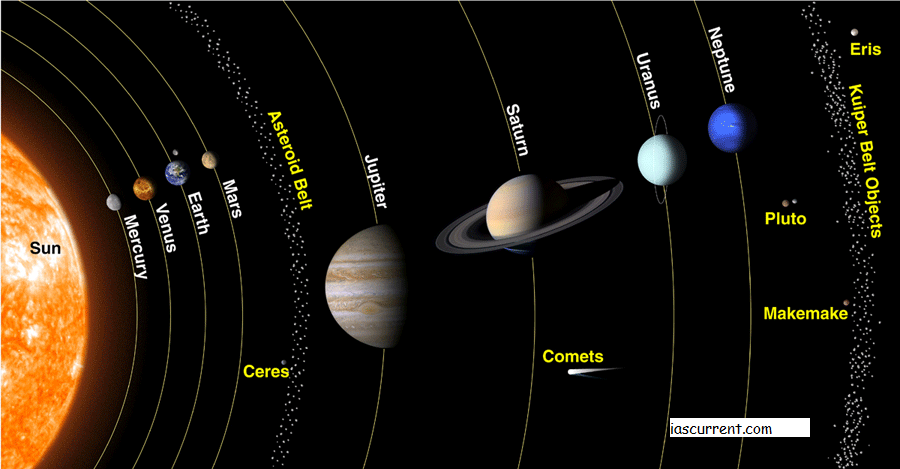The Solar system can be defined as the system which bounded due to gravitational force around the Sun and objects such as planets, dwarf planets, solar system bodies that revolve around the Sun. Many theories have been put forward by many astronomers and thinkers.

Geocentric Theory of the Solar System
According to this, the earth is in the center, and the sun revolves around it. Plato accepted this theory. Ptolemy, Aristotle, etc lent credence to it.
The Heliocentric Theory of The Solar System
This theory was given by Copernicus, who said that the sun is at the center and it is the planets that are revolving around the sun. Galileo was the first person who invented the telescope to see the motion of the planets
But according to Copernicus, the orbit of the planets was circular. Kepler was the first person to claim that the orbit of the planets is not circular. It is elliptical.
Sun is never in the center of the ellipse according to Kepler. It is located at one of the two foci of the ellipse. This way, while revolving around the sun, the planets or the earth come close to the sun and move away from the sun. In the case of the earth, the earth is closest to the sun on 3rd January and farthest on 4th July.
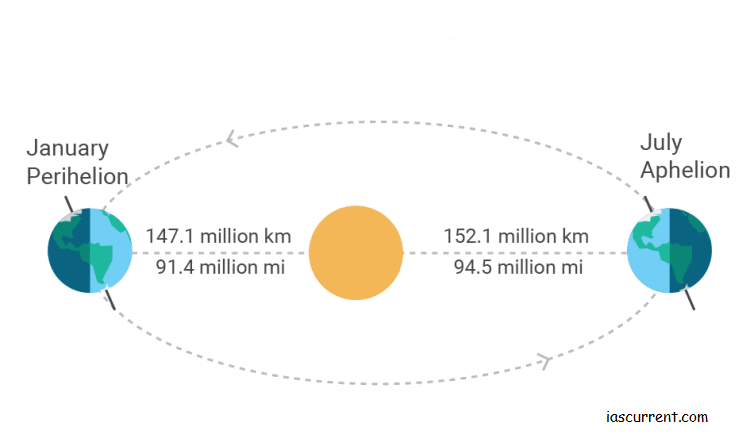
On 3rd January when the earth is closest to the sun, there is winter in the north & summer in the south because of the Perihelion position, the winter of the north becomes wild and the summer of the south becomes hot.
Whereas on 4th July, the position of Aphelion arrives when the earth is farthest from the sun. Because of this, the summer of the northern hemisphere becomes mild and the winter of the south becomes severe. It means the winter and summer of the southern hemisphere are more extreme than the northern hemisphere.
There are eight known planets in our solar system. Pluto was termed as a planet until 2008.
- Mercury: The closest planet to the sun. It is very hot. It has no satellites.
- Venus: The 2nd planet from the sun. It is very bright. It is known as the morning and evening star. It is known as the Goddess of Beauty. It is very hot because of the presence of Co2 in its atmosphere. It has no satellites.
- Earth: The 3rd planet from the sun. It has One Satellite – The Moon, which is the largest satellite among all the satellites of terrestrial planets. [Mercury Venus Earth and Mars are called Terrestrial Planets. Jupiter, Saturn, Uranus& Neptune are called Jovian planets]
- Mars: It is a red planet and the red color of mars is because of the oxidation. It has two satellites Phobos & Deimos.
- Jupiter: It is huge and the first member of the Jovian planet from the sun. It has rings but it is weak and not as bright as the ring of Saturn. The major satellites of Jupiter are Io, Europa, Ganymede, and Callisto.
- Saturn: It is known for its specific rings that are very bright and clear. It has 7 satellites and the main satellite is Titan.
- Uranus: Uranus is a unique planet. It is tilted on its axis at 98”, this is why it looks like it is rolling on its orbit. it has a blue color due to the presence of methane in its atmosphere its satellites are
- Neptune: It is the 8th and the last planet of the solar system. Neptune and Uranus are called twin planets. So are Earth & Venus, those are also called twin planets.
The Curious Case of Pluto

Before 2008, Pluto was also accepted as a member of the planetary system and it was the 9th planet of the solar system. But in 2008, IAU [International Astronomical Union] fixed two parameters for the objects to be called planets –
- The body of matter must have sufficient mars to create sufficient gravity to give the body of matter the shape of a sphere.
- The body of matter must not intersect the orbit of any other planet.
Pluto was eligible on the first criteria but since it intersects the orbit of Neptune, it was discarded from the planetary system. Now, Pluto is considered a Dwarf Planet or Plutoids. Other Plutoids are Eris, make, Haumea, etc.
Asteroids: Flying Mountains of Space
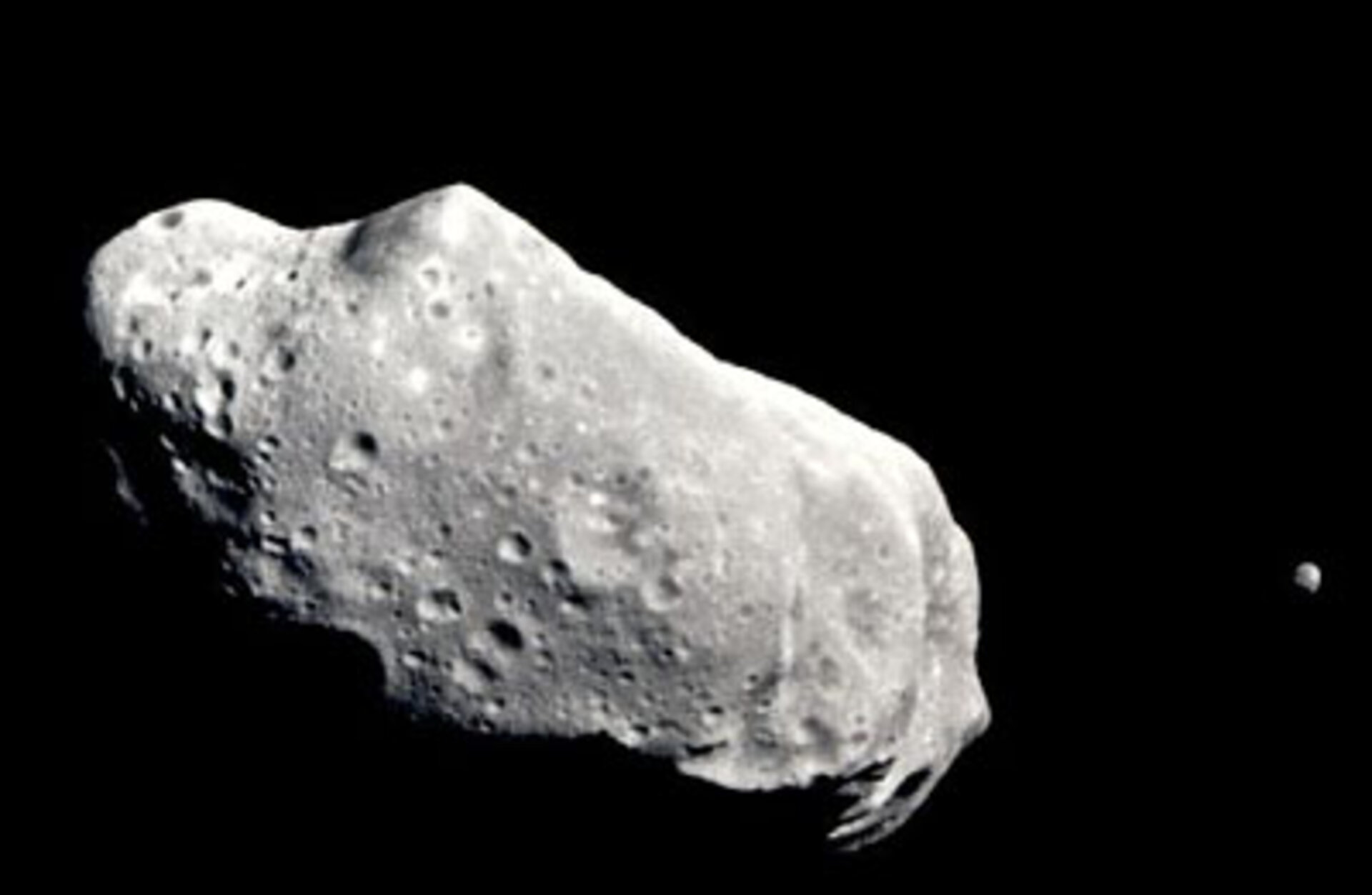
Those are the body of which are made of metals and rocks. These are called Flying Mountain also. They can differ in size from micro to macro. The largest among them is Ceris which is also called Dwarf Planet.
Comets: Revolving body around the Sun
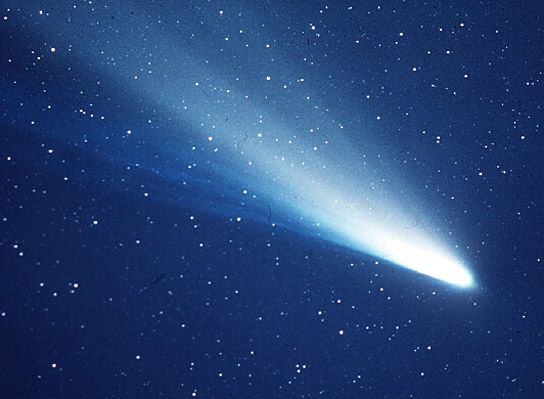
Comets are the body of matters which revolve around the sun. When it approaches the sun, its outer layer evaporates and it forms a Tail. The glowing face of the comet is called Coma.
There are two types of comets-
- The comets have a lifespan of 100 years or so. These originate on the Kuiper Belt
- The comets have a lifespan of 1000 years or so. Such comets originate from Oort Clouds. A good example of such a comet in Hailey’s Comet.
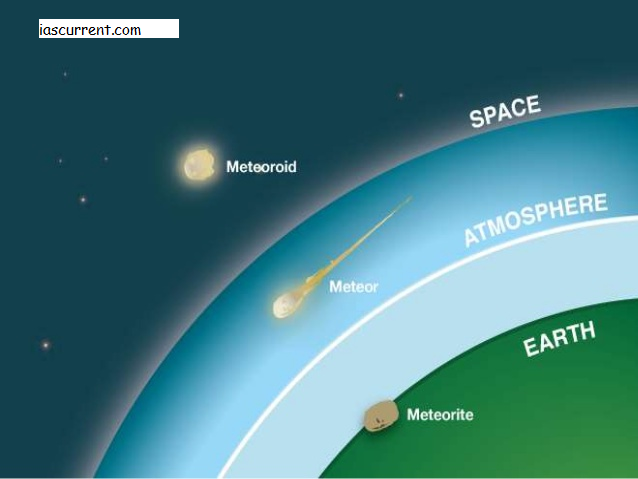
Meteoroids: Shooting Star
It is a body of matter passing through space, which when enters the earth’s atmosphere gets burnt due to friction. A burning meteoroid is called a Meteor also known as a shooting star or a falling star. When such meteors are burnt in a group it is called a meteoritic shower.
Usually, meteoroids burn in the atmosphere only. But when they reach the surface of the earth in their solid-state, these are called Meteorites. These contain 90% Iron & 10% Nickel.
Bode’s Law

This law explains the orbital distance of a planet from the sun. According to this, the distance of a planet from the sun is twice the distance of its sunward planet from the sun.

